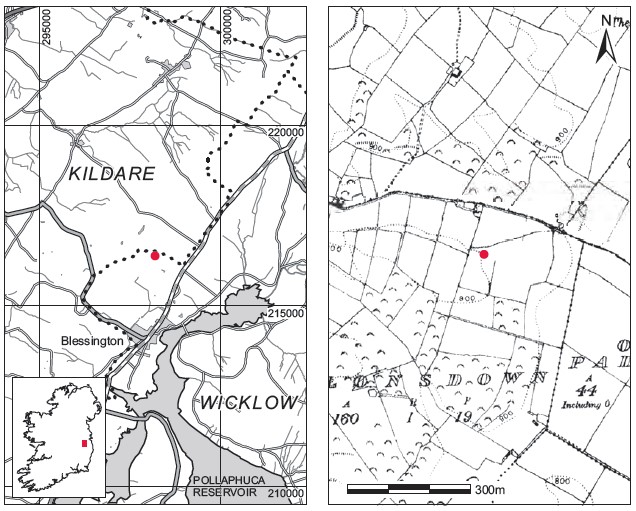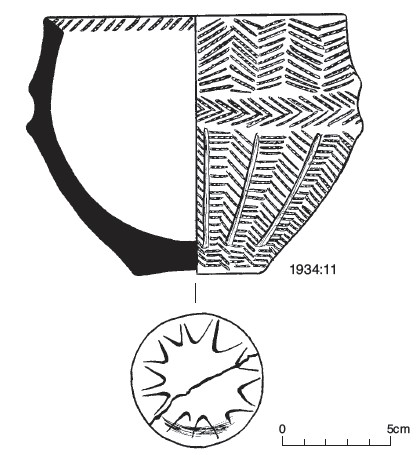County: Wicklow Site name: DILLONSDOWN, CO. WICKLOW
Sites and Monuments Record No.: SMR WI005-001 Licence number: E1192
Author: LIAM PRICE
Site type: Early Bronze Age graves
Period/Dating: —
ITM: E 698129m, N 716420m
Latitude, Longitude (decimal degrees): 53.189173, -6.531643
Introduction
In November 1934 a short cist containing an inhumation and a bowl was discovered during quarrying at a gravel pit near Blessington, Co. Wicklow. Some of the stones of the cist fell down the face of the pit, leaving the bones and vessel exposed. The site was reported to Liam Price, who subsequently investigated the cist. This report is based on Price’s excavation report.
Location (Fig. 3.239)
The site was in the townland of Dillonsdown, north-west Co. Wicklow,372 on the eastern end of a gravel ridge at an altitude of 200–250m above sea level. The gravel pit had been recently dug back to the highest part of the ridge and through this the cist was discovered.
Description of site
As the cist stones had all collapsed and fallen to the base of the quarry it was not possible to reconstruct its original shape. According to the workers at the pit, the grave was constructed of three large stones, with smaller boulders (i.e. not flags) underneath these forming what the men called a ‘passage’. It is possible that the smaller stones had acted as a support for the larger slabs above them, but it is not possible to be certain of this. The ends of the grave were apparently open. One of the larger stones was shown to Price and measured 0.51m by 0.41m by 0.41m.

The cist contained an inhumation (1934:11,119) and a tripartite bowl. The vessel had been broken, apparently when a stone had fallen on it. According to the finders, there was no skull or long bones visible when the cist was discovered, and the contents had been scattered about the area when Price visited the site. No further information as to the location within the grave of the skeleton was obtained.
Tripartite bowl, 1934:11,118 (Fig. 3.240)
The vessel is broken but is of the tripartite bowl type. The lip has an inward bevel and is ornamented with slanting lines of comb ornament. Between rim and shoulder the vessel is ornamented with an uninterrupted zone of comb-impressed lines arranged in zigzag herringbone fashion around the vessel. At the shoulder is a double moulding with a groove which is decorated with slanting lines of comb ornament. From shoulder to base the vessel is divided into panels by vertical grooves, the panels in between being ornamented with zigzag comb-impressed patterns that use the grooves as centring. The base, which is concave, is decorated with a pointed star—the points being formed by depressing the clay, leaving the ‘star’ in relief.
Dimensions: H c. 13cm; ext. D c. 15cm; D of base 5.5cm.

Comment
Two radiocarbon dates were obtained, one from carbonate and the other from collagen. Brindley (2007, 68) states that the carbonate date (3730±50 BP) should not be used, as it was done as a test case.373 The collagen date is 3660±70 BP,374 which calibrates to 2280–1870 BC. Both the date and the form of the vessel place it in stage 1 of the development of the bowl tradition, which is broadly dated to 2160–2080 BC (Brindley 2007, 328). The human remains could not be re-located for the purposes of examination for this report.
372. Parish of Blessington, barony of Talbotstown Lower. SMR WI005-001——. IGR 298200 216390.
373. GrA-13330.
374. OxA-2672.